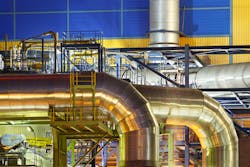The physical properties, operating conditions and operating constraints of a combustion air flowmeter for an incinerator were discussed last month. Combustion air flow measurements were required for flows of 15 to 700 units and the flowmeter had to measure zero flow under reverse flow conditions, lest the fumes overpower the combustion air fan and escape to the atmosphere.
Pipe size (24-inch) precluded the application of many flowmeter technologies in this application. Most full-bore flowmeters could not be used because of size and/or cost. Various types of insertion flowmeters could be applied. Full-bore and insertion differential pressure flowmeters might also be applicable.
Turndown flow requirements eliminate even more flowmeter technologies. For example, the effective 45-to-1 flow measurement turndown with a differential pressure flowmeter would result in a differential pressure turndown of 2,025-to-1. Differential pressure transmitters can exhibit somewhat reasonable accuracy over approximately a 5-to-1 flow measurement turndown. Stated differently, the differential pressure generated at low combustion air flow rates would be too low for an industrial differential pressure transmitter to measure accurately.
Reverse flow requirements further eliminate flowmeter technologies. For example, an insertion vortex flowmeter could not be used because it registers reverse flow as if it were forward flow. Therefore, a flow switch would be needed to force the transmitter output to zero flow under reverse flow conditions.
In the end, an insertion turbine flowmeter with a quadrature amplifier (to sense reverse flow and force the output to zero) met all of the requirements for this application and enabled the incinerator to operate more efficiently for years. In addition, accuracy was reasonable because flowmeter performance was expressed as a percentage of flow rate (not full scale) over the applicable range.
In summary, selecting a flowmeter to measure a common fluid (air) operating at nonextreme conditions (atmospheric pressure and ambient temperature) can become a challenge because of the constraints of the process in which the flowmeter must operate.
David W. Spitzer is a regular contributor to Flow Control magazine and a principal in Spitzer and Boyes LLC, which offers engineering, seminars, strategic, marketing consulting, distribution consulting and expert witness services for manufacturing and automation companies. Spitzer and Boyes is also the publisher of the Industrial Automation INSIDER. He has more than 40 years of experience and has written more than 10 books and 350 articles about flow measurement, instrumentation and process control.
Spitzer may be reached at 845-623-1830 or via spitzerandboyes.com. Click on the “Products” tab to find his Consumer Guides to various flow and level measurement technologies.



